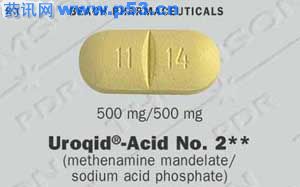|
Uroqid-acid no. 2 tablets Description Clinical Pharmacology Indications and Usage Prophylactic Use Rationale: Urine is a good culture medium for many urinary pathogens. Inoculation by a few organisms (relapse or reinfection) may lead to bacteriuria in susceptible individuals. Thus, the rationale of management in recurring urinary tract infection (bacteriuria) is to change the urine from a growth-supporting to a growth-inhibiting medium. There is a growing body of evidence that long-term administration of methenamine can prevent recurrence of bacteriuria in patients with chronic pyelonephritis. Therapeutic Use Rationale: Helps to sterilize the urine and, in some situations in which underlying pathologic conditions prevent sterilization by any means, can help to suppress bacteriuria. As part of the overall management of the urinary tract infection, a thorough diagnostic evaluation should accompany the use of this product. Contraindications Precautions UROQID-Acid No.2 contains approximately 83 mg of sodium per tablet and should be used with caution in patients on a sodium-restricted diet. Sodium phosphates should be used with caution in the following conditions: cardiac failure; peripheral or pulmonary edema; hypernatremia; hypertension; toxemia of pregnancy; hypoparathyroidism; and acute pancreatitis. High serum phosphate levels increase the incidence of extraskeletal calcification. Large doses of methenamine (8 grams daily for 3 to 4 weeks) have caused bladder irritation, painful and frequent micturition, albuminuria and gross hematuria. Dysuria may occur, although usually at higher than recommended doses, and can be controlled by reducing the dosage. This product contains a urinary acidifier and can cause metabolic acidosis. Care should be taken to maintain an acidic urinary pH (below 5.5), especially when treating infections due to urea-splitting organisms such as Proteus and strains of Pseudomonas. Drugs and/or foods which produce an alkaline urine should be restricted. Frequent urine pH tests are essential. If acidification of the urine is contraindicated or unattainable, use of this product should be discontinued. Information For Patients: To assure an acidic pH, patients should be instructed to restrict or avoid most fruits, milk and milk products, and antacids containing sodium carbonate or bicarbonate. Laboratory Tests: As with all urinary tract infections, the efficacy of therapy should be monitored by repeated urine cultures. During long-term therapy, careful monitoring of renal function, serum phosphorus and sodium may be required at periodic intervals. Drug Interactions: Formaldehyde and sulfamethizole form an insoluble precipitate in acid urine and increase the risk of crystalluria; therefore, these products should not be used concurrently. Thiazide diuretics, carbonic anhydrase inhibitors, antacids, or urinary alkalinizing agents should not be used concurrently since they may cause the urine to become alkaline and reduce the effectiveness of methenamine by inhibiting its conversion to formaldehyde. Concurrent use of antihypertensives, especially diazoxide, guanethidine, hydralazine, methyldopa, or rauwolfia alkaloids; or corticosteroids, especially mineralocorticoids or corticotropin, with sodium phosphates may result in hypernatremia. Concurrent use of salicylates may lead to increased serum salicylate levels since excretion of salicylates is reduced in acidified urine. Serum salicylate levels should be closely monitored to avoid toxicity. Laboratory Test Interactions: Formaldehyde interferes with fluorometric procedures for determination of urinary catecholamines and vanilmandelic acid (VMA) causing erroneously high results. Formaldehyde also causes falsely decreased urine estriol levels by reacting with estriol when acid hydrolysis techniques are used; estriol determinations which use enzymatic hydrolysis are unaffected by formaldehyde. Formaldehyde causes falsely elevated 17-hydroxycorticosteroid levels when the Porter-Silber method is used and falsely decreased 5-hydroxyindoleacetic acid (5HIAA) levels by inhibiting color development when nitrosonaphthol methods are used. Carcinogenesis, Mutagenesis, Impairment Of Fertility: Long-term animal studies to evaluate the carcinogenic, mutagenic, or impairment of fertility potential of this product have not been performed. Pregnancy: Teratogenic Effects. Pregnancy Category C. Animal reproduction studies have not been conducted with UROQID-Acid No.2. It is also not known whether this product can cause fetal harm when administered to a pregnant woman or can affect reproductive capacity. Since methenamine is known to cross the placental barrier, this product should be given to a pregnant woman only if clearly needed. Nursing Mothers: Methenamine is excreted in breast milk. Caution should be exercised when this product is administered to a nursing woman. Adverse Reactions Gastrointestinal upset (diarrhea, nausea, stomach pain, and vomiting) may occur with the use of sodium phosphates. Also, bone or joint pain (possible phosphate induced osteomalacia) could occur. The following adverse effects may be observed (primarily from sodium): headaches; dizziness; mental confusion; seizures; weakness or heaviness of legs; unusual tiredness or weakness; muscle cramps; numbness, tingling, pain, or weakness of hands or feet; numbness or tingling around lips; fast or irregular heartbeat; shortness of breath or troubled breathing; swelling of feet or lower legs; unusual weight gain; low urine output, unusual thirst. Dosage and Administration How Supplied PRODUCT PHOTO(S): The product samples shown here have been supplied by the manufacturer. While every effort has been made to assure accurate reproduction, please remember that any visual identification should be considered preliminary. In cases of poisoning or suspected overdosage, the drug's identity should be verified by chemical analysis. ------------------------------------------------------------------------------------------------------------------------ 【原产地英文商品名】UROQID-ACID NO.2 500mg:500mg/tab 100tabs/bottle 中文:乌洛托品片说明 临床药理学 适应症 预防性使用的理由:尿是许多尿病原体的良好培养基。由(复发或再感染)很少生物体接种可能导致易感个体菌。因此,管理的经常性尿路感染(菌)的理由是要改变从一个以增长为支持一个生长抑制介质的尿液。有证据表明,是一种长期乌洛托品政府可以防止慢性肾盂肾炎复发的患者越来越多菌。 治疗使用的理由:帮助消毒尿液,并在某些情况下,潜在的病理条件防止任何手段消毒,可以帮助抑制菌。作为尿路感染的整体管理的一部分,彻底诊断的评价应伴随着这一产品的使用。 UROQID铅酸® 2号含有约83毫克和每片钠的患者应采用谨慎的钠,限制饮食。 磷酸钠应慎用下列条件:心脏衰竭;外设或肺水肿;高钠血症,高血压,妊娠毒血症的;甲状旁腺功能低下症和急性胰腺炎。高血磷浓度增加骨外钙化的发生率。 大剂量的乌洛托品(8克3至4周),造成膀胱发炎,疼痛,尿频,蛋白尿和血尿。排尿困难可能发生,但通常比推荐剂量更高,而且可以通过减少剂量控制。本产品包含一个尿酸化剂,可以引起代谢性酸中毒。 应注意保持酸性尿pH值(低于5.5),特别是由于感染治疗时,如变形杆菌和假单胞菌株尿素分裂生物体。 药物和/或食物而产生的碱性尿液应该受到限制。频繁的尿液pH值的测试是必不可少的。如果尿液酸化是禁忌或高不可攀,使用本产品,应停止使用。 对于患者的信息:要保证酸性pH值,患者应限制或避免指示大多数水果,牛奶及奶制品,和制酸剂含有碳酸钠或碳酸氢钠。 实验室检查:对于所有泌尿道感染,治疗效果应通过反复尿培养监测。在长期的治疗,肾功能,血清磷,钠小心监测可能需要在定期间隔。 实验室试验相互作用:甲醛的荧光干扰程序的尿儿茶酚胺和vanilmandelic酸(VMA的)造成错误很高的成绩的决心。通过与甲醛也会导致雌三醇当酸水解技术被用于降低尿雌三醇虚假反应水平;它使用雌三醇测定水解酶是由甲醛不受影响。甲醛引起假性升高17 hydroxycorticosteroid当波特-西尔伯方法是使用和虚假下降了5 -羟丁酸(5HIAA)通过抑制彩色发展水平时,nitrosonaphthol方法用于水平。 致癌,诱变,生育减值:长期的动物研究,以评估致癌,致突变,或者该产品的潜在肥力障碍还没有被执行。 妊娠:致畸作用。妊娠类别为C类动物生殖研究尚未进行UROQID -酸®第二。这也是不知道这个产品是否会造成胎儿造成伤害管理,以孕妇或可能影响生殖能力。由于胺是已知的跨越胎盘屏障,本产品应给予孕妇只有在确实需要。 哺乳母亲:胺是分泌乳汁。应谨慎行事时,该产品是护理管理,以一个女人。 不良反应 胃肠道不适(腹泻,恶心,胃痛,呕吐)可能会发生钠磷酸盐的使用。此外,骨骼或关节疼痛(可能引起骨软化症磷酸盐)可能发生。下列不良影响,可观察到(主要是钠):头痛,眩晕,精神错乱,抽搐,虚弱或沉重的双腿,异常疲倦或虚弱,肌肉痉挛,麻木,刺痛,疼痛,或手或脚无力,麻木或刺痛嘴唇周围,快速或不规则心跳,呼吸急促或呼吸困难;脚或下肢水肿,异常的体重增加,低尿量,不寻常的渴望。 剂量和用法 如何提供 |


